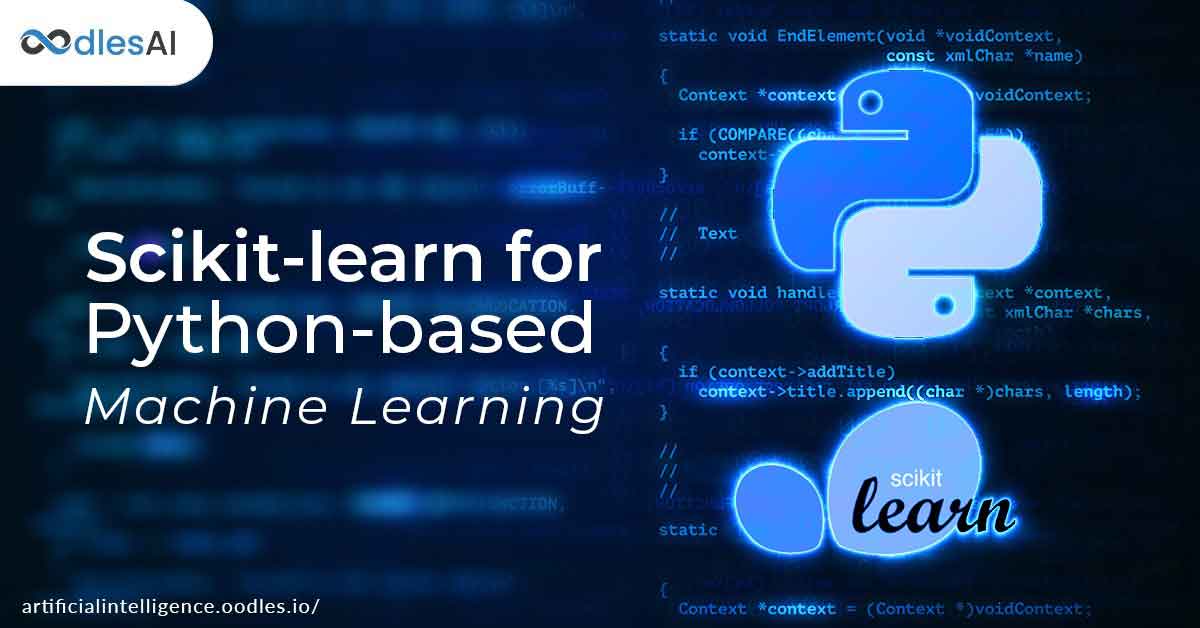Why Scikit-learn is Optimum for Python-based Machine Learning
Sanam Malhotra | 31st December 2019

Artificial intelligence (AI) and Machine Learning (ML) are capturing greater business value with powerful algorithms and functionalities. As an emerging AI development company, Oodles AI has witnessed a growing demand for cutting-edge AI solutions across markets. It has propelled the development of significant ML libraries, such as ‘Scikit-learn’ for machine learning applications like predictive analytics, sentiment analysis, and more.
This blog post analyzes the inside out of Scikit-learn and maps effective business applications with the comprehensive ML library.
Significance of Scikit-Learn for Python-based Machine Learning
Scikit-learn is a machine learning library developed in Python. It was initially started as a Google Summer of Code project by David Cournapeau in 2007. The name “Scikit” has its roots attached to the “SciPy”, a scientific computing library developed in 2001. Scikit-learn is developed on top of two such computational libraries and functions, namely SciPy, NumPy, and Matplotlib.
Today, global businesses like JP Morgan and Spotify use Scikit-learn’s ML algorithms, making it the most widely-used Python package.
With expansive implementations of machine learning algorithms, Scikit-learn is considered as the most comprehensive ML library. Its open-source nature makes Scikit-learn easily accessible along with the following features-
a) Efficient Data Analysis
Scikit -learn accelerates the development of ML models with considerable support for large volumes of data mining and analysis.
b) Supervised and Unsupervised learning algorithm
The scikit-learn toolbox is a mixed bag for diverse supervised and unsupervised algorithms. From supervised linear regression and support vector to clustering and principal component analysis under unsupervised neural networks.
c) High Accuracy Rate
With features like cross-validation, scikit-learn offers a high level of accuracy in the development of machine learning solutions.
Python-based Machine Learning Applications using Scikit-learn
1) Predictive Analytics Models
With an explosion in digital information and data, today businesses are able to explore new machine learning opportunities. Combined with in-depth analytics, machine learning and artificial intelligence are making strides with accurate, comprehensive, and timely insights.
Contrary to traditional predictive analytics that ran with a considerable time lag, AI-powered predictive modeling with scikit-learn apply the following methodologies-
a) Linear Regression
Linear regression and classification are the two types of supervised machine learning algorithms. While the former is used to predict a continuous value, the latter predicts a discrete value as the output. Scikit-learn’s machine learning library supports both dense and sparse inputs to predict near-real-time values or targets.

b) Classification
The scikit-learn library offers two classification models, namely Logistic Regression (LogReg) and K-Nearest Neighbors (KNN). While LogReg is used to predict multi-class targets, KNN classifies the value based on the nearest numbers.
Under Scikit-learn, Regression and Classification are two important ML algorithms that improve the accuracy and efficiency of predictive analytics models significantly.
Also read- Mobilizing Big Data for Cloud-based Predictive Analytics
Diabetes Predictive System built by Oodles AI
At Oodles, we used scikit-learn’s to implement machine learning algorithms for developing a Diabetes Predictive System. The model predicts diabetes in a person based on several data inputs such as glucose, kin thickness, blood pressure, etc. We applied Scikit-learn’s AdaBoostClasssifier machine learning algorithm along with large volumes of structured datasets.

Our AI team used various algorithms such as-
a) Linear Regression
b) Logistic Regression
c) Support Vector Machine, and more.
Our Diabetes Prediction System has successfully achieved above 95% accuracy in predicting human diabetes levels without any intervention of physicians.
Also read- Improving Diagnostics with AI-powered Predictive Analytics in Healthcare
2) Sentiment Analysis Models
The proliferation of digital communication and socializing channels has given way to a trove of textual information and audience expressions. Businesses can channelize this data to extract actionable insights that strengthen their marketing and decision-making abilities.
The AI behind sentiment analysis enables machines to analyze the ‘sentiment’ or ‘emotion’ underlying words, sentences, social media comments, and articles. The system uses Natural Language Processing (NLP) algorithms to classify opinions as a positive, negative, skeptic, etc. to improve the following business operations-
a) Enhance customer support services and experience using audience insights
b) Augment better Public Relations (PR) practices
c) Formulation of effective marketing strategies
d) Management of business reputation early-warning systems
e) Monitor remote and cross-border customers
Scikit-learn’s machine learning algorithms enable businesses to analyze real-time online customer interactions with logistic regression model development. The library can be easily used to monitor customer behavior across social media channels and messaging applications.
Also read- Potential Business Applications of Sentiment Analysis Across Industries
Deploying Scikit-learn for Machine Learning Applications with Oodles AI
We, at Oodles AI, have hands-on experience in deploying function-specific machine learning algorithms of Scikit-learn to build dynamic AI solutions. Our machine learning capabilities with Scikit-learn extend to text classification, predictions, and NLP systems along with business-oriented cloud machine learning solutions. With adept knowledge in model training for supervised and unsupervised machine learning algorithms, we match the AI requirements of multiple industry businesses.
Talk to our AI team to know more about our artificial intelligence services.



